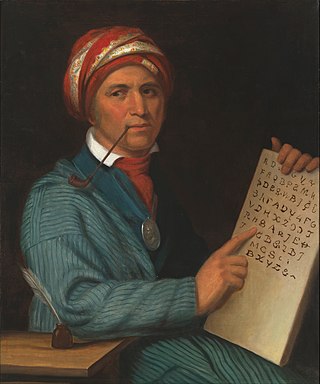
The Cherokee are one of the Indigenous peoples of the Southeastern Woodlands of the United States. Prior to the 18th century, they were concentrated in their homelands, in towns along river valleys of what is now southwestern North Carolina, southeastern Tennessee, southwestern Virginia, edges of western South Carolina, northern Georgia and northeastern Alabama consisting of around 40,000 square miles

The Muscogee, also known as the Mvskoke, Muscogee Creek or just Creek, and the Muscogee Creek Confederacy, are a group of related Indigenous peoples of the Southeastern Woodlands in the United States. Their historical homelands are in what now comprises southern Tennessee, much of Alabama, western Georgia and parts of northern Florida.

Indian Territory and the Indian Territories are terms that generally described an evolving land area set aside by the United States government for the relocation of Native Americans who held original Indian title to their land as an independent nation-state. The concept of an Indian territory was an outcome of the U.S. federal government's 18th- and 19th-century policy of Indian removal. After the American Civil War (1861–1865), the policy of the U.S. government was one of assimilation.
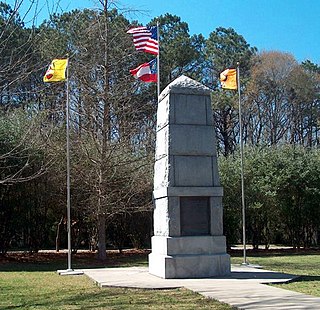
The Trail of Tears was an ethnic cleansing and forced displacement of approximately 60,000 people of the "Five Civilized Tribes" between 1830 and 1850 by the United States government. As part of the Indian removal, members of the Cherokee, Muscogee (Creek), Seminole, Chickasaw, and Choctaw nations were forcibly removed from their ancestral homelands in the Southeastern United States to newly designated Indian Territory west of the Mississippi River after the passage of the Indian Removal Act in 1830. The Cherokee removal in 1838 was brought on by the discovery of gold near Dahlonega, Georgia, in 1828, resulting in the Georgia Gold Rush.

The term Five Civilized Tribes was applied by white Americans in the colonial and early federal period in the history of the United States to the five major Native American nations in the Southeast: the Cherokee, Chickasaw, Choctaw, Muscogee (Creek), and Seminoles. White Americans classified them as "civilized" because they had adopted attributes of the Anglo-American culture.

John Ross was the Principal Chief of the Cherokee Nation from 1828 to 1866; he served longer in that position than any other person. Described as the Moses of his people, Ross influenced the nation through such tumultuous events as the relocation to Indian Territory and the American Civil War.

The Creek War, was a regional conflict between opposing Native American factions, European powers, and the United States during the early 19th century. The Creek War began as a conflict within the tribes of the Muscogee, but the United States quickly became involved. British traders and Spanish colonial officials in Florida supplied the Red Sticks with weapons and equipment due to their shared interest in preventing the expansion of the United States into regions under their control.

The Territory South of the River Ohio, more commonly known as the Southwest Territory, was an organized incorporated territory of the United States that existed from May 26, 1790, until June 1, 1796, when it was admitted to the United States as the State of Tennessee. The Southwest Territory was created by the Southwest Ordinance from lands of the Washington District that had been ceded to the U.S. federal government by North Carolina. The territory's lone governor was William Blount.
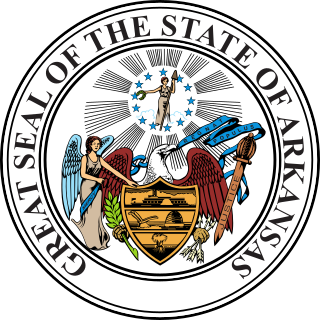
The Arkansas Territory was a territory of the United States that existed from July 4, 1819, to June 15, 1836, when the final extent of Arkansas Territory was admitted to the Union as the State of Arkansas. Arkansas Post was the first territorial capital (1819–1821) and Little Rock was the second (1821–1836).
Cherokee Nation v. Georgia, 30 U.S. 1 (1831), was a United States Supreme Court case. The Cherokee Nation sought a federal injunction against laws passed by the U.S. state of Georgia depriving them of rights within its boundaries, but the Supreme Court did not hear the case on its merits. It ruled that it had no original jurisdiction in the matter, as the Cherokees were a dependent nation, with a relationship to the United States like that of a "ward to its guardian," as said by Chief Justice Marshall.

Major Ridge, The Ridge was a Cherokee leader, a member of the tribal council, and a lawmaker. As a warrior, he fought in the Cherokee–American wars against American frontiersmen. Later, Major Ridge led the Cherokee in alliances with General Andrew Jackson and the United States in the Creek and Seminole wars of the early 19th century.
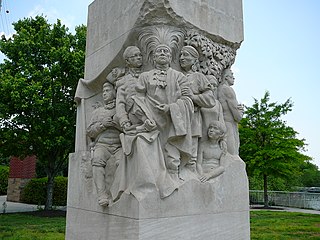
The Treaty of Holston was a treaty between the United States government and the Cherokee signed on July 2, 1791, and proclaimed on February 7, 1792. It was negotiated and signed by William Blount, governor of the Southwest Territory and superintendent of Indian affairs for the southern district for the United States, and various representatives of the Cherokee peoples, most notably John Watts. The treaty established terms of relations between the United States and the Cherokee, and established that the Cherokee tribes were to fall under the protection of the United States, with the United States managing all future foreign affairs for all the loosely affiliated Cherokee tribes.

John Jolly was a leader of the Cherokee in Tennessee, the Arkansaw district of the Missouri Territory, and Indian Territory. After a reorganization of the tribal government around 1818, he was made Principal Chief of the Cherokee Nation–West. Jolly was a wealthy slave-owning planter, cow rancher, and merchant. In many ways, he lived the life of a Southern planter.
The Cherokee have participated in over forty treaties in the past three hundred years.

Cherokee history is the written and oral lore, traditions, and historical record maintained by the living Cherokee people and their ancestors. In the 21st century, leaders of the Cherokee people define themselves as those persons enrolled in one of the three federally recognized Cherokee tribes: The Eastern Band of Cherokee Indians, The Cherokee Nation, and The United Keetoowah Band of Cherokee Indians.

The Cherokee Nation was a legal, autonomous, tribal government in North America recognized from 1794 to 1907. It was often referred to simply as "The Nation" by its inhabitants. The government was effectively disbanded in 1907, after its land rights had been extinguished, prior to the admission of Oklahoma as a state. During the late 20th century, the Cherokee people reorganized, instituting a government with sovereign jurisdiction known as the Cherokee Nation. On July 9, 2020, the United States Supreme Court ruled that the Muscogee (Creek) Nation had never been disestablished in the years before allotment and Oklahoma Statehood.
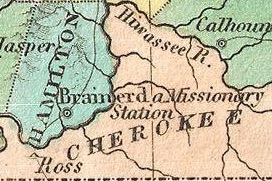
Cherokee removal, part of the Trail of Tears, refers to the forced relocation between 1836 and 1839 of an estimated 16,000 members of the Cherokee Nation and 1,000–2,000 of their slaves; from their lands in Georgia, South Carolina, North Carolina, Tennessee, and Alabama to the Indian Territory in the then Western United States, and the resultant deaths along the way and at the end of the movement of an estimated 4,000 Cherokee and unknown number of slaves.

The Treaty of Pontotoc Creek was a treaty signed on October 20, 1832 by representatives of the United States and the Chiefs of the Chickasaw Nation assembled at the National Council House on Pontotoc Creek in Pontotoc, Mississippi. The treaty ceded the 6,283,804 million acres of the remaining Chickasaw homeland in Mississippi in return for Chickasaw relocation on an equal amount of land west of the Mississippi River.

Sam Houston had a diverse relationship with Native Americans, particularly the Cherokee from Tennessee. He was an adopted son, and he was a negotiator, strategist, and creator of fair public policy for Native Americans as a legislator, governor and president of the Republic of Texas. He left his widowed mother's home around 1808 and was taken in by John Jolly, a leader of the Cherokee. Houston lived in Jolly's village for three years. He adopted Cherokee customs and traditions, which stressed the importance of being honest and fair, and he learned to speak the Cherokee language. He felt that Cherokees and other indigenous people had been short-changed during negotiation of treaties with United States government, the realization influenced his decisions as a military officer, treaty negotiator, and in his roles as governor of the states of Tennessee and Texas, and president of the Republic of Texas.

















